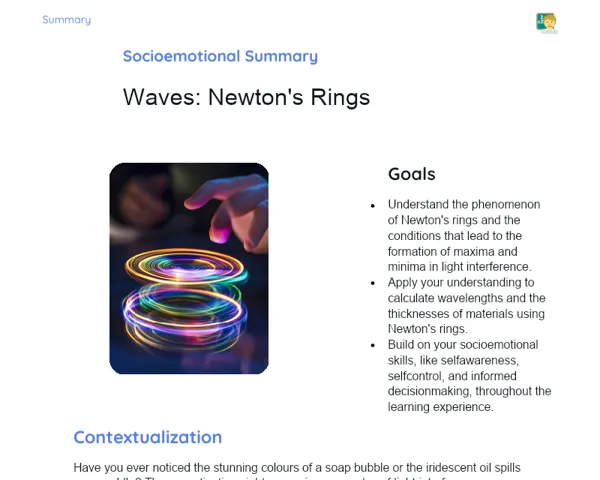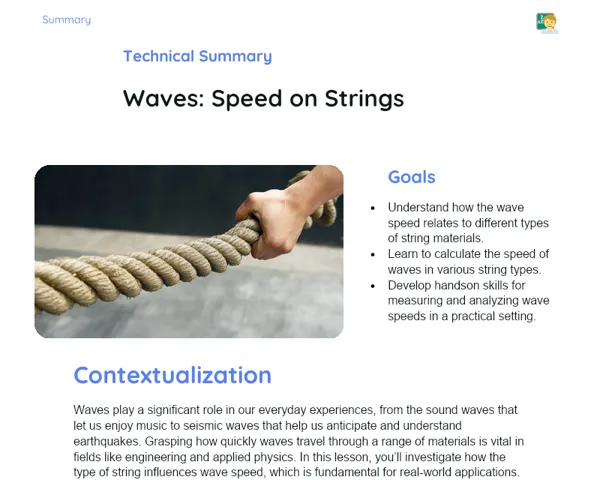Goals
1. Grasp the concept of net force and its real-life applications.
2. Calculate the work done by a net force using the formula: Work = Force x Distance x cos(θ).
Contextualization
Net force is a key concept in physics that explains how and why objects move. For example, when you push a car to get it rolling, the force you exert needs to overcome the car's weight and the friction with the road. Being able to calculate this force and the work it results in is vital in a variety of everyday situations and professional contexts, such as in automotive engineering, machine design, and construction work, where understanding the forces involved in moving heavy structures can make all the difference.
Subject Relevance
To Remember!
Concept of Net Force
Net force is the total sum of all the forces acting on an object. It determines how the object will accelerate per Newton's Second Law. If the net force isn't zero, the object will change its motion; if it is zero, the object will either stay at rest or continue moving at a steady pace.
-
Net force is calculated by adding up all the forces acting on an object.
-
It can be visually represented through the vector sum of the forces.
-
Any net force that isn’t zero results in the acceleration of the object.
Calculation of Work Done by a Force
Work done by a force is determined by the product of the applied force, the distance the object travels, and the cosine of the angle between the force and the direction of movement. The formula for work is: Work = Force x Distance x cos(θ). This calculation is essential for understanding the energy transferred to or from an object.
-
The work formula is: Work = Force x Distance x cos(θ).
-
θ represents the angle between the direction of the force and the direction of motion.
-
Work is measured in Joules (J), the standard unit of energy in the International System of Units (SI).
Application of Net Forces in Various Practical Contexts
Understanding net forces is crucial across many practical and professional fields. In engineering, it helps with ensuring structures and machines are safe and efficient. In automotive design, knowing the forces at play can boost performance and enhance vehicle safety. In sports, calculating these forces can improve athlete performance and reduce the risk of injuries.
-
In civil engineering, net forces help with the design of robust and stable structures.
-
In automotive design, they assist with optimising aerodynamics and safety features.
-
In sports, understanding net forces can lead to improved techniques and fewer injuries through a better grasp of the forces acting on the body.
Practical Applications
-
Civil Engineering: Using net forces to design and build structures and bridges that can safely bear loads.
-
Automotive Design: Assessing the forces acting on vehicles to enhance fuel efficiency and safety.
-
Sports: Applying net force principles to improve performance and mitigate the risk of injuries.
Key Terms
-
Net Force: The vector sum of all forces acting on an object.
-
Work: The product of the applied force, the distance moved, and the cosine of the angle between the force and the direction of motion.
-
Cosine (cos): A trigonometric function showing the ratio of the length of the adjacent side over the angle and the hypotenuse in a right triangle.
Questions for Reflections
-
How could understanding net force assist in resolving issues across various technical professions?
-
In what ways can the concept of work done by a force apply to your everyday experiences?
-
How might a deeper comprehension of net forces and work lead to technological advancements in the future?
Practical Challenge: Measuring Force and Work
This mini-challenge encourages you to solidify your understanding of net force and work through a practical exercise that simulates real-world situations.
Instructions
-
Form groups of 3-4 members.
-
Use the materials provided (cardboard, tape, ruler, dynamometer or calibrated elastic, and a toy car) to create a ramp with an adjustable incline.
-
Measure the force needed to pull the car up the ramp using the dynamometer.
-
Document the distance the car travels on the ramp and the angle of the ramp's incline.
-
Calculate the net force and the work done using the formula: Work = Force x Distance x cos(θ).
-
Share your findings and engage in a discussion about the variations observed with the rest of the class.



